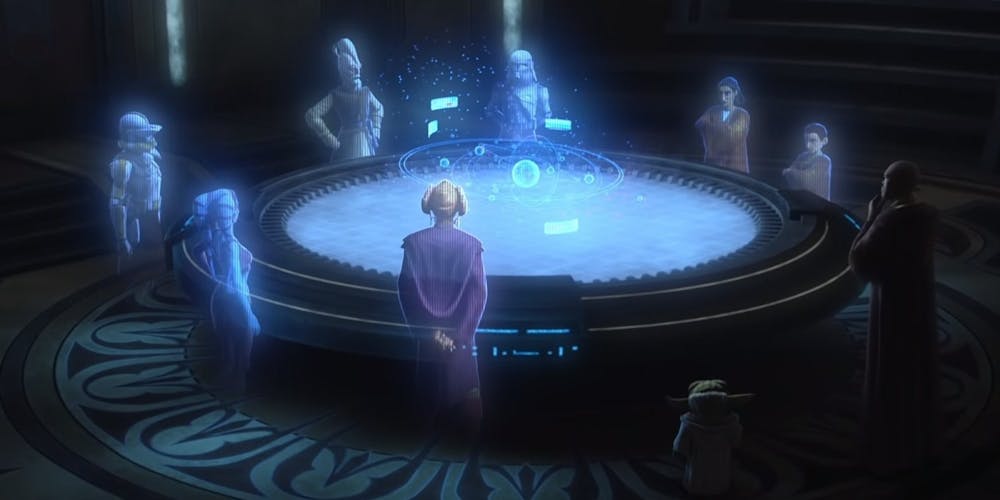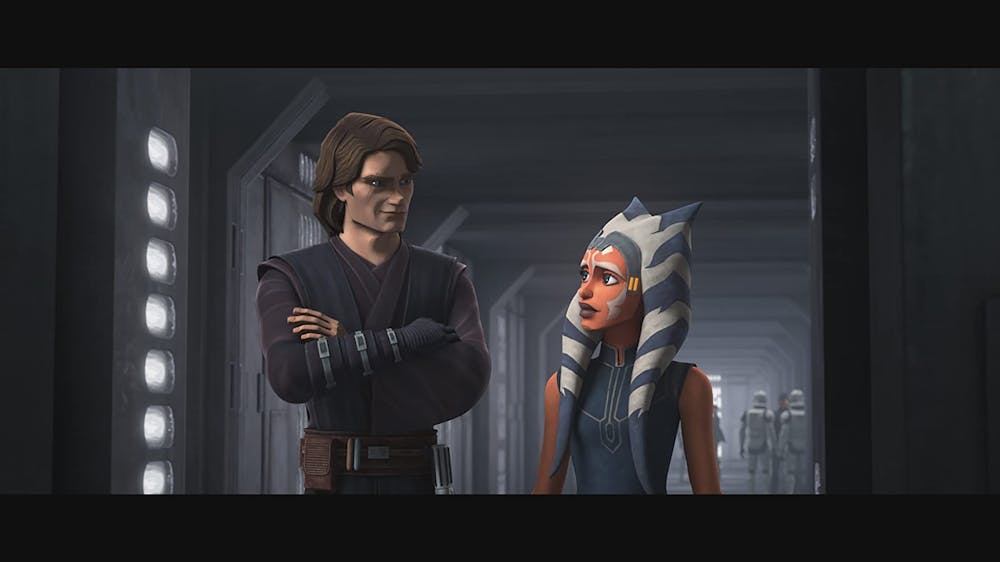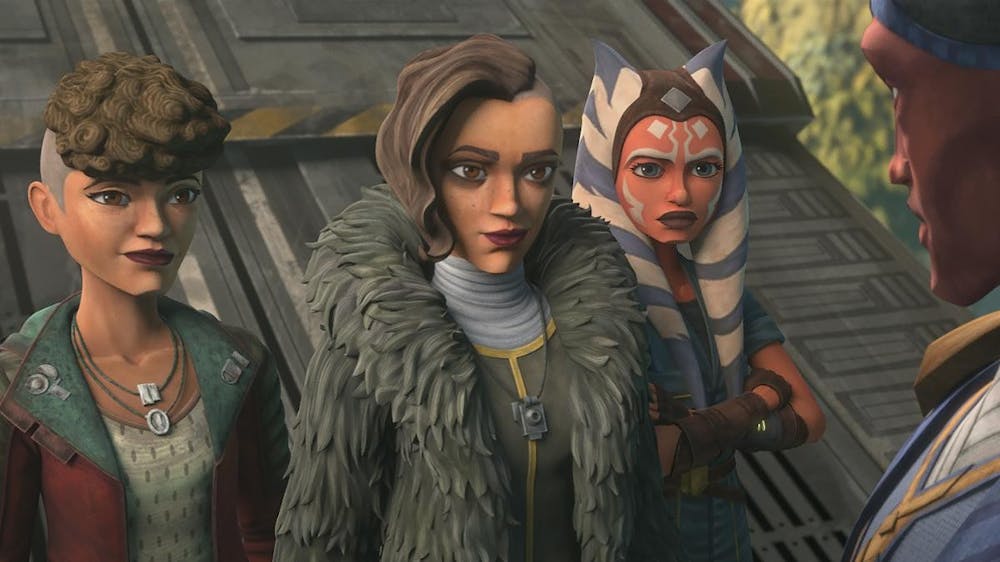Disclaimer: This review contains spoilers for Star Wars: The Clone Wars Season 7 and previous seasons.
Back in August 2008, the film Star Wars: The Clone Wars released in theaters. The Clone Wars was an animated feature, which was a first in the famous franchise. It was touted at depicting events in the Clone Wars, a climactic three-year war that began in 2002’s Star Wars: Episode II – Attack of the Clones and ended in 2005’s Star Wars: Episode III – Revenge of the Sith. The film wasn’t entirely a success, becoming the lowest-grossing and most critically panned of the Star Wars films released thus far (a title that it still holds to this day).
Note that I said it wasn’t entirely a success. Despite the complete bashing that The Clone Wars received at the box office and in reviews, it soon spawned a TV show, which began airing on Cartoon Network that October. While the first season of the show spawned mixed reviews from viewers and critics alike, the subsequent four were far more critically acclaimed. Many praised the show’s storytelling, worldbuilding (or galaxy-building because it’s Star Wars), character development, animation, and themes.
Unfortunately, The Clone Wars fate eventually fell into flux. When franchise creator George Lucas sold Star Wars to Disney in late 2012, the show ended up being cancelled by Cartoon Network, with its fifth season (which aired from September 2012 to March 2013) being the last. However, The Clone Wars was not dead just yet, as a sixth season titled The Lost Missions debuted on Netflix in 2014. The show would go on ice for the next few years, until it was revealed at the San Diego Comic-Con 2018 that The Clone Wars would be revived for a seventh and final season on the then-unnamed Disney streaming service.
The final season premiered on Disney+ on Feb. 21, 2020, and came to its conclusion on May 4 (which is Star Wars Day). Despite a few hiccups, The Clone Wars ended on a high note, cementing itself as one of the greatest things to come out of the iconic Star Wars franchise.
Three arcs, one winner
This final season of The Clone Wars consists of three four-episode story arcs: “The Bad Batch,” “Ahsoka’s Walkabout,” and “The Siege of Mandalore.”

Image from IMDb
“The Bad Batch” arc comprises episodes one through four, and follows the Battle of Anaxes, where the Galactic Republic are suffering heavy losses to the Separatists (the bad guys). Needing help to turn the tide in their favor, the Republic recruits the Bad Batch, a four-man team of genetically modified clone troopers. When it comes to this arc, I would label it as classic Clone Wars. What I mean is that when it comes to this show, there are many arcs that show off the countless battles of the Clone Wars, and said arcs illustrate fun character interactions and exhilarating action sequences. This particular arc has these qualities in spades, as the Bad Batch themselves all have distinct personalities (which, funny enough, draws a significant comparison to the Teenage Mutant Ninja Turtles) and the action sequences are truly exciting to behold (the fourth episode, “Unfinished Business” is an incredible display of this, with some awesome Jedi sequences courtesy of Anakin Skywalker). Unfortunately, the only real positive of this arc is that it’s fun and nothing much else. Don’t expect to bawl your eyes out during any of these four episodes.
The “Ahsoka’s Walkabout” arc comprises episodes five through eight. It follows former Jedi Padawan Ahsoka Tano, who had left the Jedi Order at the end of the fifth season, and her escapades with a pair of sisters, Trace and Rafa Martez. The trio become entangled with the Pyke Syndicate (a crime syndicate in the Star Wars universe), and are forced to become spice runners (drug dealers, essentially). To cut right to the chase, this is the weakest story arc of the season–maybe in the past few seasons, if I’m to be honest. While seeing Ahsoka handle post-Jedi Padawan life was nice to see, with Ashley Eckstein’s vocal performance as the character being charming as ever, the characterization of the Martez sisters and the pacing of these episodes is completely mediocre. Rafa is definitely the more interesting of the two sisters, being grey in terms of morality, and actually having a rational sense of mind. On the other hand, Trace is quite annoying, and she makes a rather idiotic choice in Deal No Deal (the sixth episode) that is outright baffling.

Image from IMDb
The final “Siege of Mandalore” arc rounds out the final four episodes. The arc depicts Ahsoka’s return to both the Jedi and the Republic, where she travels to the planet Mandalore in order to capture the rogue crime lord and Sith apprentice Maul. Without a shadow of a doubt, this arc is some of the best storytelling that not only The Clone Wars has done, but Star Wars in general. Practically everything in this arc works, from the action sequences to the vocal performances to the emotional weight. I cannot stress this enough: “The Siege of Mandalore” is absolutely incredible. So incredible, in fact, that another section is needed to discuss its significance.
Sieging your emotions
From the second the “Siege of Mandalore” arc begins, it’s apparent that things are going to get very serious. Rather than have the traditional triumphant fanfare of the typical Clone Wars episode, these episodes have no fanfare at all; the only things that even suggest fanfare are the classic Lucasfilm logo from the 1970s and the episode titles. This choice is fitting considering that the events of this arc are happening concurrently with Revenge of the Sith. No jokes here, scenes and even exact dialogue from the film are replicated within the arc, which not only ties both mediums together, but also shows how the events of Revenge of the Sith directly affect characters in the show.

Image from IMDb
This arc ultimately ends in heartbreak, with Order 66 being enacted, which causes all of the clones to turn against Ahsoka and try to kill her. However, with the help of Commander Rex, one of her closest friends, who is also a clone, she escapes and manages to survive the whole ordeal. The emotional weight that comes from Ahsoka and Rex’s interactions is powerful, as the both of them have to deal with the fact that all of their friends are actively trying to hunt them down (a scene where Rex starts tearing up really hit me). The final moments of the arc, with Ahsoka and Rex burying the clones after they all died in a ship crash is haunting, as there is not a single line of dialogue said — only Kevin Kiner’s excellent Blade Runner-esque score playing in the background.
This haunting tone permeates till the very end of the finale “Victory and Death,” with the final shot being that of a cracked clone trooper’s helmet. The symbolism is evident here, illustrating that at this point, the Clone Wars are over and the Republic is well and truly dead.
Would you look at that
A noticeable improvement in this final season of The Clone Wars is the animation. Unlike in the previous seasons, particularly the first, the animation here is stunning. Characters move more effortlessly and fluidly than ever before. The various planets, from the mountainous regions of Anaxes to the dense cityscapes of Coruscant, are brought to life in such wonderful detail. The cinematography also aids in demonstrating the animation’s upgrade, with large, wide-open plains and battlegrounds being put on display.

Featured Image: IMDb
Images: IMDb
For more entertainment related content, visit us at Byte BSU!





The Daily News welcomes thoughtful discussion on all of our stories, but please keep comments civil and on-topic. Read our full guidelines here.